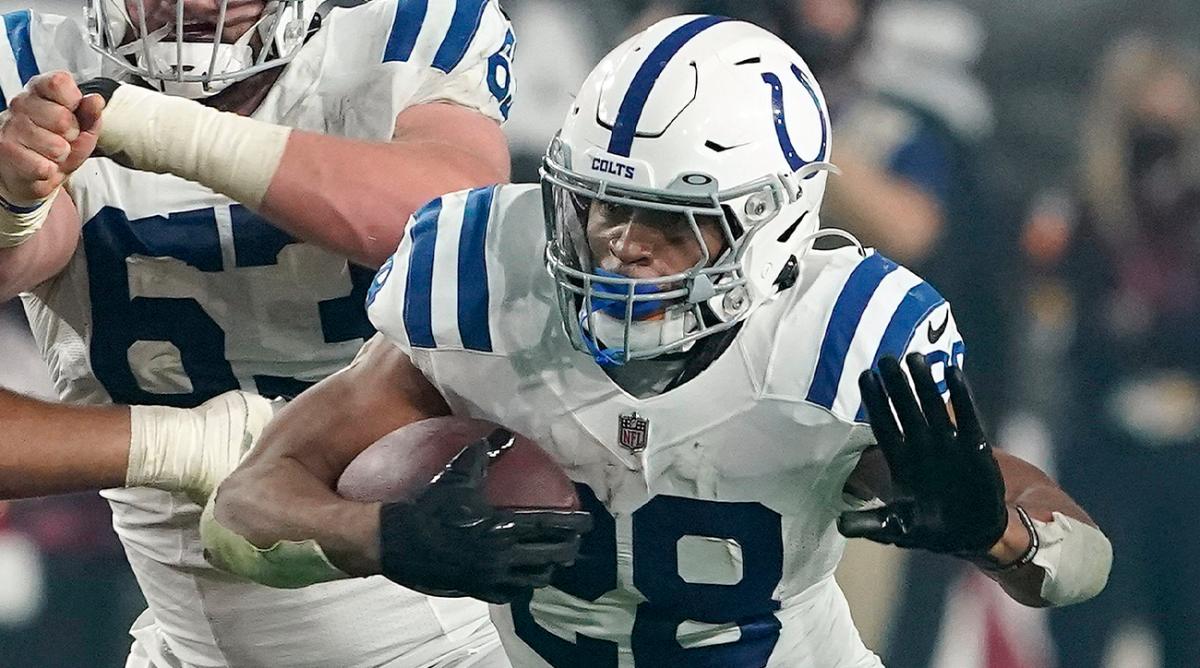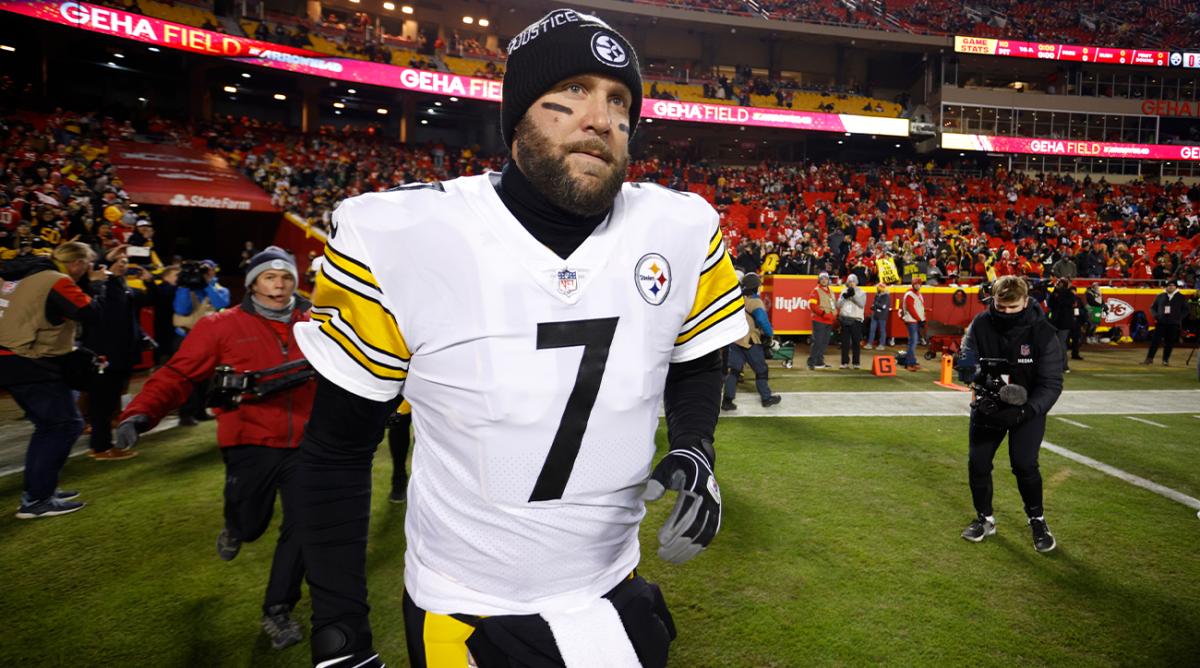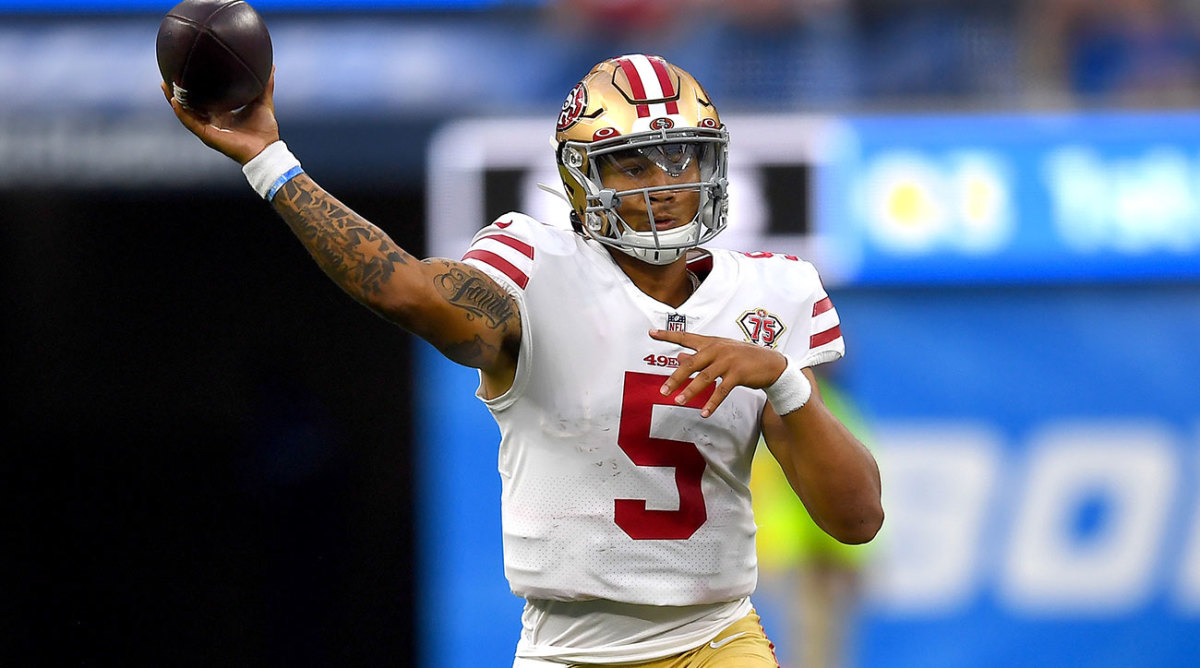Jonathan Taylor or Christian McCaffrey? Time to Start Thinking About 2022 Fantasy Football Season
Super Bowl LVI closed the door on the 2021 NFL season, but it’s never too early to start thinking about 2022 fantasy football drafts. More questions than answers lie ahead for anyone forecasting next season. Christian McCaffrey’s reign as the fantasy football king might be over, but is a recent injury history really enough to unseat him from the top spot? What will be the ripple effects of decisions made by Russell Wilson and Aaron Rodgers about their futures? And is 2022 the last gasp for former fantasy elites like Dalvin Cook and Alvin Kamara?
We dive into those questions, and more:
Is Jonathan Taylor the new 1.01?
Conventional wisdom says yes. Jonathan Taylor started to take the lion’s share of the Colts’ backfield touches in Week 5 and from that point forward he averaged 26.1 PPR points per game. That was a full 4.1 points better than the Austin Ekeler, the RB3, and 6.0 points better than Alvin Kamara, the RB5.. In other words, Taylor smashed on his No. 11 average draft position (ADP) and provided the positional advantage drafters seek when selecting a first-round running back.

It’s easy to lose sight of how unique Taylor’s season was. Since 2000, 286 players have averaged between 15-23 carries and less than three receptions per game. Only four of those 286 players have averaged more than 22 PPR points per game: Clinton Portis (2003), Larry Johnson (2005), Adrian Peterson (2012) and now Taylor.
Fantasy seasons like Taylor’s happen once or twice a decade. Expected points (EP) can help dig into why that is. EP, the fantasy equivalent of nerdspeak, takes the context of a given carry or target — like down, distance and field position — and tells us how many points a player should score. It shows a player’s baseline opportunity, and talented players are expected to outperform those numbers.
Taylor finished 2021 with 14.0 and 4.5 rushing and receiving EP per game*, respectively. That’s short of the workload typically seen from league-winning running backs, who often eclipse 20.0 total EP, because Nyheim Hines cuts into enough of Taylor’s receiving role. The numbers show what everyone can see: Taylor is that good. He can outperform a slightly smaller workload because he’s a hyper-efficient, generational player. A top-10 offensive line helps, too.
This is where Christian McCaffrey reenters the 1.01 conversation. McCaffrey averaged 23.9 PPR points per game in his five full games (a small sample) even though he scored just two touchdowns. His underlying opportunity (10.5 rushing EP and 11.0 receiving EP) remained strong while he was the league’s second-most efficient back in the passing game. In short, McCaffrey is still a PPR cheat code when healthy. The when healthy part is the holdup for a 25-year-old RB who has missed 22 games in the last two seasons.
So, who is the 1.01? Taylor is an ascending talent and doesn’t have the durability concerns that McCaffrey does. The hope is that Taylor maintains his dominant second-half rushing market share (94% in Weeks 10-17 vs. 74% in Weeks 1-9) and supports that with enough receiving production if the Colts run into more negative game scripts. He’d look a lot like the monster season Derrick Henry was having before his injury. For those reasons, Taylor is the new 1.01.
The existence of Hines, though, means the gap between Taylor and McCaffrey shouldn’t be as big as recency bias makes it seem. And, yes, McCaffrey still warrants the 1.02 over the likes of Henry and Austin Ekeler.
*Expected Points metrics via RotoViz
How much can we trust aging star running backs?
The numbers say not much. Since 2014, only five running backs age 27 or older have averaged more than 18.0 PPR points per game and played in at least 12 games. That leaves Derrick Henry, Alvin Kamara, Dalvin Cook, Austin Ekekler, Ezekiel Elliott and Aaron Jones — all of whom will be at least 27 years old when the 2022 season begins — on the precipice of a cliff.
The game has changed, especially for dominant rushers like Henry. Teams are less likely to saddle aging running backs with true bellcow workloads. In the past, it was easier for backs like Edgerrin James and Curtis Martin to hit a top-five season late in their career when they were handed 360 carries. Now, the ceiling outcome for those types of players usually features a touchdown spree like Marshawn Lynch’s 2014 season. It’s harder to stomach the risk at ADP when the dropoff is coming.
There’s some hope for pass-catching backs. Four of those five 27-and-older backs who made the cut had at least 5.8 receiving EP per game. It’s easier for the Kamara and Ekeler types (and Cook, to a lesser extent) to hold on for one last top-flight fantasy season when their receiving work can offset diminishing rushing workloads. Even then, though, no age 27 or older running back has topped 18.0 PPR points per game in the last five seasons.
That 18.0 PPR/g threshold is a low bar for a first- or second-round pick. It falls in what Establish the Run’s Michael Leone dubbed the “silent killer” range, where a player provides adequate production in the RB1 slot but not enough to offset the cost of passing on an elite wide receiver.
Is this group of veteran star running backs talented enough to escape that range? Yes. Age alone isn’t enough to write off a player. Will Henry probably make all of this analysis look foolish? Also yes. Should you count on it? Probably not.
One final stat: 35 running backs age 26 or younger have crossed 18.0 PPR/g over at least 12 games in the last five seasons. Err on the side of youth.
What’s the fallout from a shifting QB landscape?
Three of the NFL’s four longest-tenured quarterbacks with one team — Ben Roethlisberger (Pittsburgh, 18 years), Aaron Rodgers (Green Bay, 17 years) and Russell Wilson (Seattle, 10 years) — might have either played their final snap or will have new stadiums to call home in 2022. Roethlisberger’s retirement not only represents the end of an era in Pittsburgh, but also a change in the fantasy fortunes for several skill position groups as well. The same would be true in Green Bay and Seattle if their star QBs move on.

Of those teams, the Steelers have the most to gain. Roethlisberger ranked 30th in deep ball completion percentage (30.2%) and 34th in air yards per attempt (6.7 air yards/attempt). Pittsburgh ranked 22nd in red-zone touchdown percentage (54.7%), too. Average-or-better quarterback play would unlock Chase Claypool’s deep-threat potential, capitalize on Diontae Johnson’s superb route running and raise Najee Harris’s touchdown ceiling.
After that, Rodgers and Wilson’s decisions leave a few question marks for their respective receivers. Davante Adams, an unrestricted free agent, faces either an uncertain future with a new team or a presumed dropoff with a new quarterback in Green Bay if Rodgers is moved. D.K. Metcalf and Tyler Lockett haven’t built enough of a sample without Wilson, but Lockett appears to be the more QB-dependent of the two. (In a very limited three-game sample, Metcalf averaged more points per game without Wilson while Lockett averaged less.)
A host of QB-needy teams lie in wait. The Broncos are one franchise quarterback away from becoming the “it” team of the offseason. Other than the Steelers, no skill position group would receive as big a boost as Denver’s with a quarterback upgrade. The Saints, Bucs, Raiders, Dolphins and Eagles are wild cards, too, some requiring more gymnastics for a QB change than others.
Buckle up. There’s a lot that could change in the next few months, with cascading fantasy consequences.
Is QB streaming dead?
QB streaming, as a strategy, depends on three core principles:
- Quarterback scoring is relatively flat. Outside of a few top options, there’s not a huge difference between other players at the position.
- Replacement-level options on the waiver wire score enough points to keep up with week-to-week starters.
- Those replacement-level options are easily identifiable on a weekly basis. A waiver wire QB has no use if players can’t accurately predict their performance.
In 2020 and 2021, QB streaming was much more difficult. Inflated QB scoring at the top of the position in ‘20 meant that replacement-level options weren’t scoring nearly enough points to tread water. In ‘21, high-end QB scoring came back down but replacement-level quarterback scoring nosedived, meaning the gap between starters and streamers was about as wide as it was in 2020.
Where does that leave the state of QB streaming? It’s hard to say, and the answer depends on how much risk a player is willing to take. QB streaming can rebound in 2022 if that replacement tier of quarterbacks is reestablished. The easiest route to that path is if second-year quarterbacks like Trey Lance, Justin Fields, Trevor Lawrence, Mac Jones and Zach Wilson continue to develop and improve. Other pathways include strong campaigns from Tua Tagovailoa and Daniel Jones, or if veteran signal callers like Kirk Cousins, Derek Carr and Matt Ryan provide enough value.
Betting on QB streaming in 2022 is a bet on those names. However, there’s enough reason for drafters to pick their spots and select an elite QB in the fifth round or wait to select a Trey Lance or Jalen Hurts type player after the seventh round. There, the opportunity costs are more palatable and quarterbacks offer more ceiling than their streaming counterparts.
Which teams are the most important to “figure out”?
With early pre-draft best ball ADPs from Underdog, a few teams pose early questions for drafters:
Ravens: Will Baltimore continue to pass at league-average levels, or will the team revert to a run-heavy offense? The Ravens relied on the passing game more with injuries to the team’s top two running backs (JK Dobbins and Gus Edwards), top blocking tight end (Nick Boyle) and tackle Ronnie Stanley. Baltimore’s newfound inclination to throw shouldn’t be completely discounted, but it’s also risky to trust. Some caution is needed with Mark Andrews’s borderline Round 2 ADP.

49ers: If Trey Lance (QB10) becomes the starter, how will that impact the 49ers’ offense? Wide receiver Deebo Samuel (WR6) is a one-of-a-kind fantasy producer, but he faces some regression if his 23 red-zone looks – sixth-most among wideouts – are reduced by Lance. The passing pie might shrink, too, if the offense becomes even more run-centric.
Bengals: Who is Cincinnati, really? From Week 1 through 13, the Bengals ranked 19th in neutral situation pass frequency (50.8%). After that point and through the AFC Championship game, Cincinnati’s neutral situation pass frequency jumped to 57.3%. If Zac Taylor continues to favor the passing game in 2022, Joe Burrow, Ja’Marr Chase, Tee Higgins and Joe Mixon have explosive potential in a dynamic offense. A more balanced approach would put a damper on that.
Giants: Every Giants player has a suppressed ADP, and rightfully so. But if there’s any coaching staff that could turn the Giants offense around, it would be the new Brian Daboll-Mike Kafka combination. Saquon Barkley (RB12), Kadarius Toney (WR43), Kenny Golladay (WR59) and Daniel Jones (QB24) are all values at ADP if signs of life creep into MetLife Stadium.
Cardinals: Christian Kirk, A.J. Green, Zach Ertz, James Conner and Chase Edmonds will all become unrestricted free agents this offseason. Who will Arizona retain, and who will they bring in to fill the holes left behind? The answers to those questions impact wideouts DeAndre Hopkins and Rondale Moore, who would benefit from less target competition.
More fantasy & NFL coverage:
